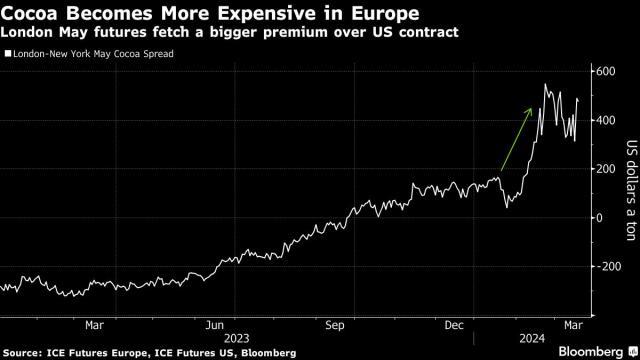Surging cocoa prices are being felt most in Europe, the world’s biggest chocolate consuming region, as new sustainability rules threaten to exacerbate a shortage of beans.
Poor harvests in West Africa have sent global futures soaring to unprecedented highs. But fears are mounting that the European Union’s incoming regulations — aimed at stopping products that destroy forests from being sold in shops — will make it even harder for the bloc’s top chocolate makers to secure supplies as consumption holds up.
Those worries are already being reflected in the futures market. In less than two months, the premium that the nearby London cocoa contract commands over its New York counterpart has jumped from about $40 a ton to more than $400. That’s far higher than the average of roughly $40 seen over the last two decades, according to Bloomberg calculations based on most-active contracts.

The big premium highlights how the industry is willing to pay up for beans that are currently stored in Europe, especially with uncertainty over how supplies will fare once the EU’s deforestation rules kick in at the end of December. Companies will need to trace beans from pod to port — not an easy task for the complex cocoa supply chain that depends on impoverished African farmers.
Concerns about cocoa supplies into Europe are also being heightened by the region’s low inventories at a time when grindings — where cocoa is processed into products used in confectionery — are holding up relatively well compared with North America and Asia.
“There’s a combination of stockpiles falling and factories’ needs to get their beans before the deforestation regulation makes it harder,” said Tom Wigglesworth, an analyst at Complete Commodity Solutions.
There’s another sign of bigger costs in Europe. Cocoa butter, a key chocolate ingredient extracted from beans, was at a record $21,800 a ton in Europe, according to data last week from KnowledgeCharts, a unit of Commodities Risk Analysis. That’s more than $1,000 above US prices.
Chocolate Threat
The supply threat is bad news for chocolatiers, particularly in Europe, a region that last year processed more than three times as much as in North America.
Surging costs are already forcing companies to raise prices for consumers, and sell bars that are smaller or which have less chocolate in them. Switzerland’s Barry Callebaut AG, which supplies some of the biggest consumer chocolate brands, expects acute cocoa shortages to persist into next season.
Europe “faces more inflation than any other market,” Luca Zaramella, chief financial officer of Toblerone maker Mondelez International Inc., said on an earnings call in January. Lindt & Spruengli AG has also pointed to expectations of prices remaining high.
The fallout of the EU Deforestation Regulation could also shake up cocoa trade flows and regional stockpiles, according to Steve Wateridge, head of research at Tropical Research Services.
“If there’s a risk that the EUDR will restrict the flow of cocoa into Europe, then it’s going to free up more cocoa for the rest of the world, particularly New York,” he said. While US stockpiles are healthier than in Europe, “that probably won’t last, because ultimately if that premium for London moves to a certain level, people will move cocoa from New York to London.”

Follow us on social media: